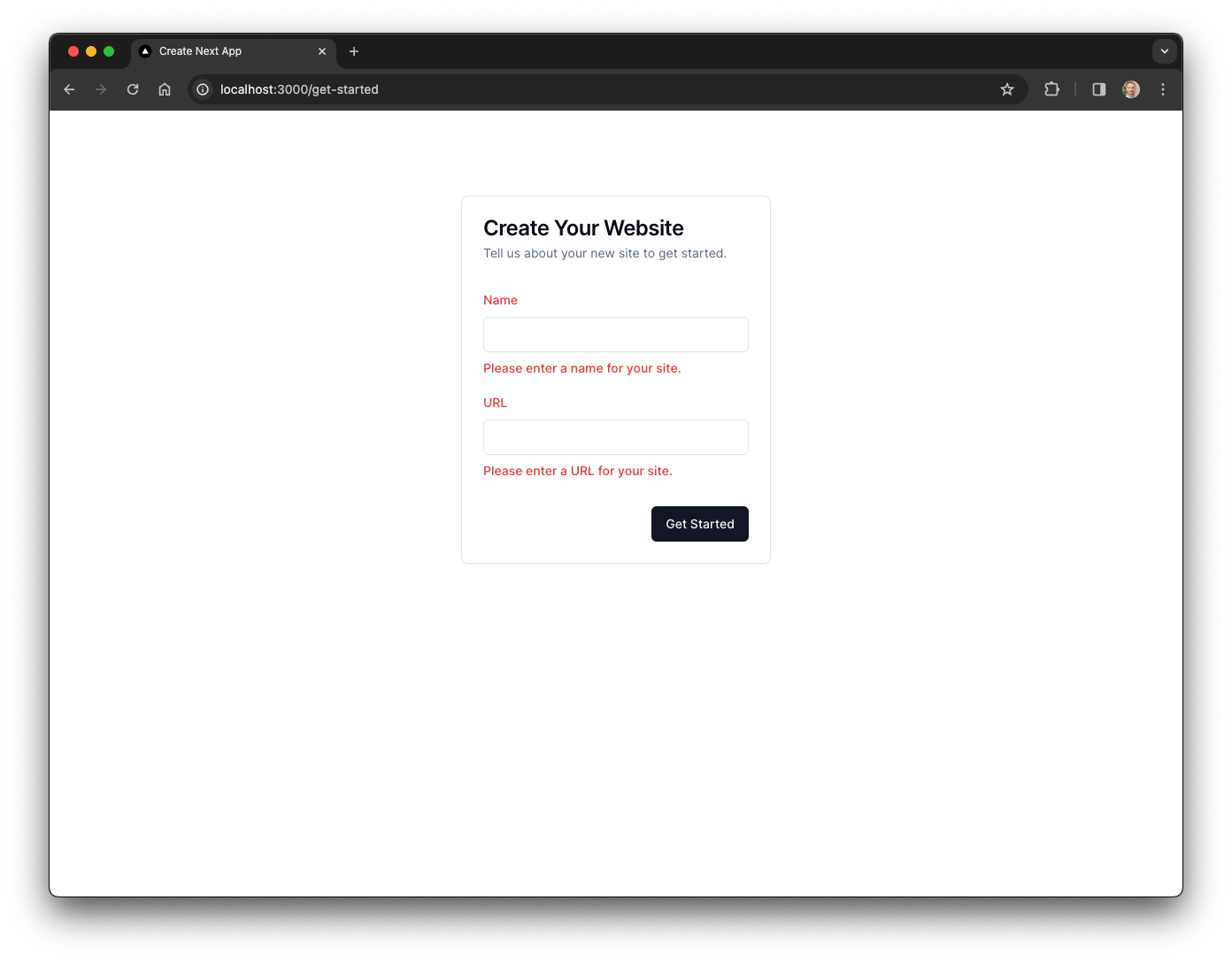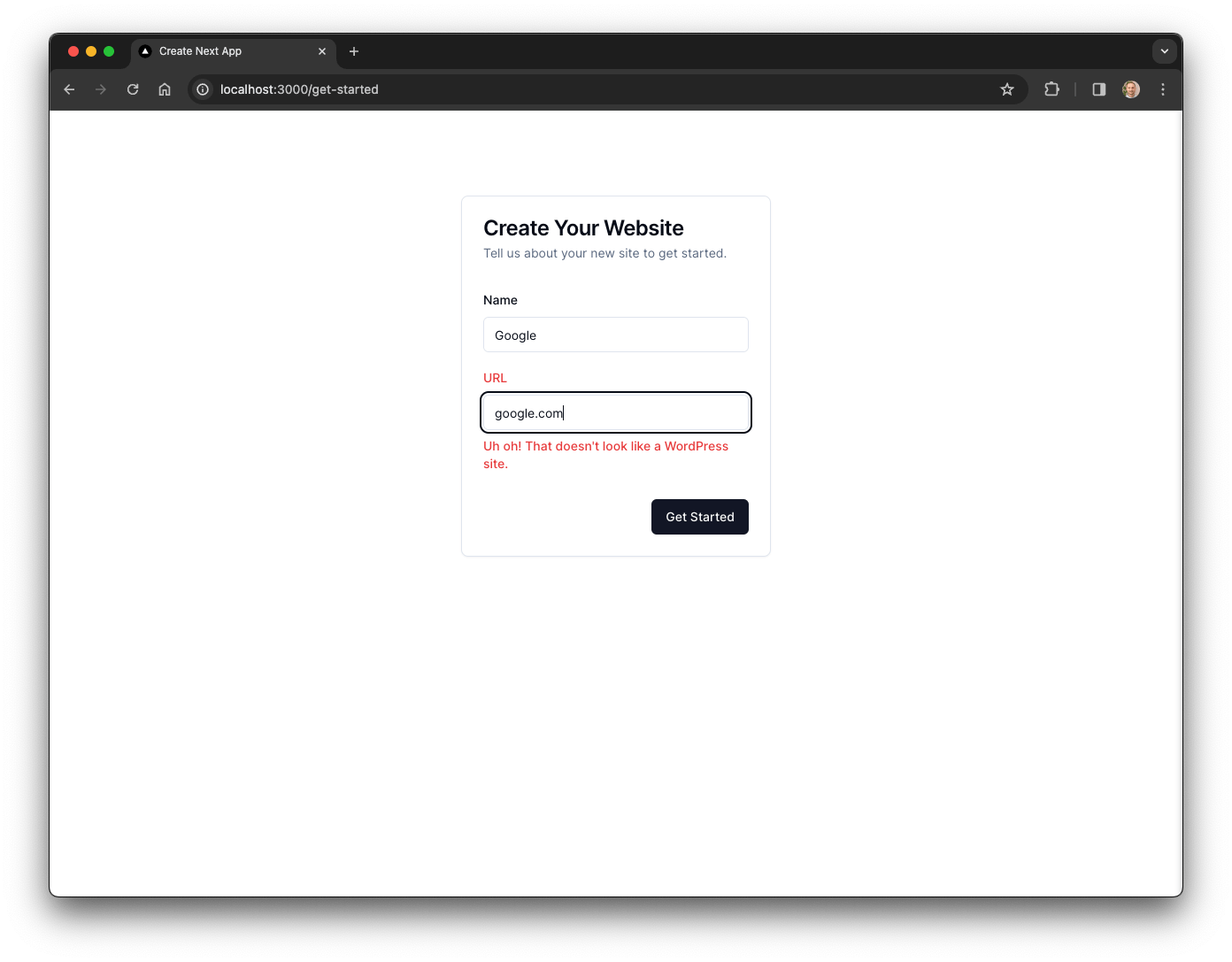Async Form Validation with Zod & React Hook Form
A Guide to Using Zod to Validate Input Fields with Asynchronous Functions
This post is a continuation of my series on building forms in Next.js. If you'd like to follow along, feel free to check out Create Your First Next.js App and Create a Form with React Hook Form & Next.js
The Validation Schema
Since we're using Zod to create our validation schema, we need to define a couple more imports in our component.
In @/components/site-form.tsx, add the following imports which we installed earlier:
// @/components/site-form.tsx
// ... imports
import { zodResolver } from "@hookform/resolvers/zod";
import { z } from "zod";
export const SiteForm = () => {
// ... SiteForm component
};
Now that we've imported zod as our external validation library and @hookform/resolvers which enables react-hook-form to work with external validation libraries, we can build our form schema.
Update the code as follows:
// @/components/site-form.tsx
// ... imports (no changes needed)
// Add the Zod validation schema
const FormSchema = z.object({
name: z.string().min(1, {
message: "Please enter a name for your site."
}),
url: z.string().min(1, {
message: "Please enter a URL for your site."
}).max(255, {
message: "URL must be less than 255 characters."
})
})
export const SiteForm = () => {
const form = useForm<z.infer<typeof FormSchema>>({
resolver: zodResolver(FormSchema), // <-- Add the resolver prop
defaultValues: {
name: "",
url: "",
},
mode: "onChange" // <-- Add the mode prop
});
const {
setValue, // <-- Add the setValue prop
handleSubmit,
control,
} = form;
// Add this handleChange() function
const handleChange = (
e: React.ChangeEvent<HTMLInputElement>,
fieldName: keyof z.infer<typeof FormSchema>
) => {
const { value } = e.target; // <-- Extract the value
setValue(fieldName, value, { shouldDirty: true, shouldValidate: true }); // <-- Set the form value
console.log(`${fieldName}: `, value);
};
// Update the onSubmit() function with type safety
// now that we have a validation schema
const onSubmit = (values: z.infer<typeof FormSchema>) => {
console.log(values, "values")
};
// Update the Inputs to use handleChange()
return (
// ...
<FormField
control={control}
name="name"
render={({ field }) => (
<FormItem>
<FormLabel>Site Name</FormLabel>
<FormControl>
<Input
{...field}
onChange={(e) => handleChange(e, field.name)}
/>
</FormControl>
<FormMessage />
</FormItem>
)}
/>
<FormField
control={control}
name="url"
render={({ field }) => (
<FormItem>
<FormLabel>URL</FormLabel>
<FormControl>
<Input
{...field}
onChange={(e) => handleChange(e, field.name)}
/>
</FormControl>
<FormMessage />
</FormItem>
)}
/>
// ...
)
};
Code Review
🤔 What this code does:
Define our initial validation schema with
zod. (Zod Documentation)Update the
useForm()hook to include theresolverandmodeproperties that tell react-hook-form how to validate the form and when we want the validation to be triggered.Add a custom, type-safe
handleChange()function that we'll be using to identify and process change events from the two fields.Add type-safety to the
useForm()hook and theonSubmit()function.Update the Inputs so they use the new
handleChange()function.
The Result
We now have some very basic form validation. If you save the file, reload localhost:3000/get-started and click the "Get Started" button, you should see the error messages we created:

Asynchronous Validation
Having a form with basic validation is great, but our goal is to pass the URL to an asynchronous function where we'll initiate a HTTP request to confirm whether the website is built with WordPress or not.
Create the Async Function
In the /lib folder, create a file named wordpress.ts and copy this code into the file:
// @/lib/wordpress.ts
"use server" // <-- Important!
export const checkUrl = async (
url: string
): Promise<boolean> => {
// Initialize as falsy
let isWordPress: boolean = false;
try {
// Send a HEAD request to the provided URL
const response = await fetch(url, {
method: "HEAD",
})
// Check the headers for the presence of the WordPress API
// Further checks will be needed to determine if the site is WordPress
// when the Rest API is disabled (uncommon)
const headerLinks = response.headers.get("link") || "";
if (headerLinks?.includes("https://api.w.org")) {
isWordPress = true;
}
} catch (error) {
console.log("Error parsing response headers: ", error);
}
// Return the result as a boolean
return isWordPress!!;
}
Don't forget to add the "use-server" directive at the beginning of this file. This is necessary when importing a server-side function into a client component. If you don't add the directive, you'll get a CORS error. (Read the Next.js Docs)
Code Review
🤔 What this code does:
Create a server-side async helper function
checkUrl()that we can use throughout our appSend a HEAD request to the URL that the function accepts as an argument
Return a boolean indicating whether the WordPress REST API was detected
Advanced Validation Methods (.transform and .refine)
Now that we have our async function that sends a HEAD request and returns a boolean, let's incorporate it into our FormSchema along with some regex.
For more advanced functionality beyond simple checks like .min() and .max, Zod provides several schema methods that open up a world of possibilities. The 2 schema methods we'll be using in this project are .transform and .refine.
Here's the new validation schema:
// @/components/site-form.tsx
// ... imports
import { checkUrl } from '@/lib/wordpress.ts';
const httpRegex = /^(http|https):/
const completeUrlRegex = /^https?:\/\/(?:www\.)?[-a-zA-Z0-9@:%._+~#=]{1,256}\.[a-zA-Z0-9()]{1,6}\b(?:[-a-zA-Z0-9()@:%_+.~#?&/=]*)$/
const FormSchema = z.object({
name: z
.string()
.min(1, {
message: "Please enter a name for your site."
})
.max(255, {
message: "Name must be less than 255 characters."
}),
url: z
.string()
.min(1, {
message: "Please enter a URL for your site."
})
.max(255, {
message: "URL must be less than 255 characters."
})
.transform((val, ctx) => {
let completeUrl = val;
// Prepend https:// if the URL
// doesn't start with http:// or https://
if (!httpRegex.test(completeUrl)) {
completeUrl = `https://${completeUrl}`;
}
// If the URL is still invalid, display an error message
// and pass the fatal flag to abort the validation process early
// This prevents unnecessary requests to the server to check
// if the URL is a WordPress site
if (!completeUrlRegex.test(completeUrl)) {
ctx.addIssue({
code: z.ZodIssueCode.custom,
fatal: true,
message: "Please enter a valid URL",
});
return z.NEVER;
}
return completeUrl;
})
// This refinement checks if the URL is a WordPress site
// It only runs if the URL is valid
.refine(async (completeUrl) =>
completeUrl && await checkUrl(completeUrl), {
message: "Uh oh! That doesn't look like a WordPress site.",
})
});
Code Review
🤔 What this code does:
Introduces 2 regex patterns we'll use to test the validity of the input
Adds a
.transformmethod that is used to apply proper URL structure to the input value or reject the input and abort the validation processAdds a
.refinemethod that invokes our async server functioncheckUrl()and passes the now properly formatted URL as the argument
The Result
With this updated validation schema, we can enter a URL into the form and see if it's a WordPress website!

The Final Code
Here's the final code for our Site-Form component:
// @/components/site-form.tsx
"use client"
import { zodResolver } from "@hookform/resolvers/zod";
import { useForm } from "react-hook-form";
import { z } from "zod";
import { checkUrl } from "@/lib/wordpress";
import { Button } from "@/components/ui/button";
import { Input } from "@/components/ui/input";
import {
Form,
FormControl,
FormField,
FormItem,
FormLabel,
FormMessage
} from "@/components/ui/form";
import {
Card,
CardContent,
CardDescription,
CardFooter,
CardHeader,
CardTitle
} from "@/components/ui/card";
const httpRegex = /^(http|https):/
const completeUrlRegex = /^https?:\/\/(?:www\.)?[-a-zA-Z0-9@:%._+~#=]{1,256}\.[a-zA-Z0-9()]{1,6}\b(?:[-a-zA-Z0-9()@:%_+.~#?&/=]*)$/
const FormSchema = z.object({
name: z
.string()
.min(1, {
message: "Please enter a name for your site."
})
.max(255, {
message: "Name must be less than 255 characters."
}),
url: z
.string()
.min(1, {
message: "Please enter a URL for your site."
})
.max(255, {
message: "URL must be less than 255 characters."
})
.transform((val, ctx) => {
let completeUrl = val;
// Prepend https:// if the URL
// doesn't start with http:// or https://
if (!httpRegex.test(completeUrl)) {
completeUrl = `https://${completeUrl}`;
}
// If the URL is still invalid, display an error message
// and pass the fatal flag to abort the validation process early
// This prevents unnecessary requests to the server to check
// if the URL is a WordPress site
if (!completeUrlRegex.test(completeUrl)) {
ctx.addIssue({
code: z.ZodIssueCode.custom,
fatal: true,
message: "Please enter a valid URL",
});
return z.NEVER;
}
return completeUrl;
})
// This refinement checks if the URL is a WordPress site
// It only runs if the URL is valid
.refine(async (completeUrl) =>
completeUrl && await checkUrl(completeUrl), {
message: "Uh oh! That doesn't look like a WordPress site.",
})
});
export const SiteForm = () => {
const form = useForm<z.infer<typeof FormSchema>>({
resolver: zodResolver(FormSchema),
defaultValues: {
name: "",
url: "",
},
mode: "onChange"
})
const {
setValue,
handleSubmit,
control,
} = form;
const handleChange = (
e: React.ChangeEvent<HTMLInputElement>,
fieldName: keyof z.infer<typeof FormSchema>
) => {
const { value } = e.target;
setValue(fieldName, value, { shouldDirty: true, shouldValidate: true });
};
const onSubmit = (values: z.infer<typeof FormSchema>) => {
console.log(values, "values")
}
return (
<Form {...form}>
<form onSubmit={handleSubmit(onSubmit)}>
<Card className="w-[350px]">
<CardHeader>
<CardTitle>Create Your Website</CardTitle>
<CardDescription>Tell us about your new site to get started.</CardDescription>
<CardContent className="py-6 px-0 space-y-4">
<FormField
control={control}
name="name"
render={({ field }) => (
<FormItem>
<FormLabel>Name</FormLabel>
<FormControl>
<Input
{...field}
onChange={(e) => handleChange(e, field.name)}
/>
</FormControl>
<FormMessage />
</FormItem>
)}
/>
<FormField
control={control}
name="url"
render={({ field }) => (
<FormItem>
<FormLabel>URL</FormLabel>
<FormControl>
<Input
{...field}
onChange={(e) => handleChange(e, field.name)}
/>
</FormControl>
<FormMessage />
</FormItem>
)}
/>
</CardContent>
<CardFooter className="justify-end py-0 px-0">
<Button>Get Started</Button>
</CardFooter>
</CardHeader>
</Card>
</form>
</Form>
)
}
Summary
By leveraging asynchronous validation for form fields, we can deliver a better user experience in situations where basic field validations just aren't enough.
Hopefully, next time you need to query a database or check a URL to validate a form field, you'll have some insight into how to approach the problem.
In my next post, I'm going to cover "debouncing" and how it can make your forms more efficient and performant, especially if you're using asynchronous validation.
If you'd like to be notified when my next post is published, go ahead and hit the "Subscribe" button. I'd be honored if you did.
See you soon!

